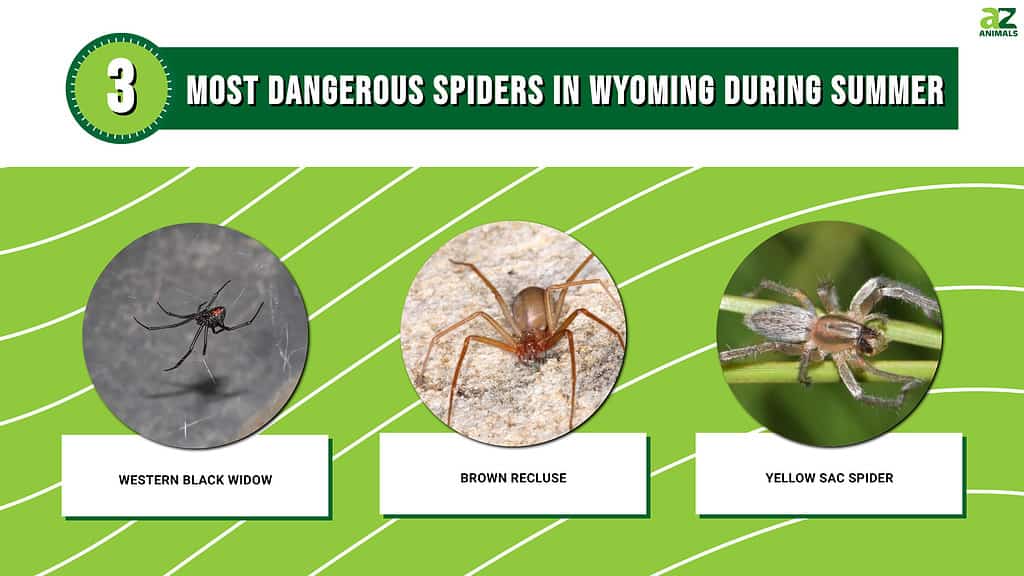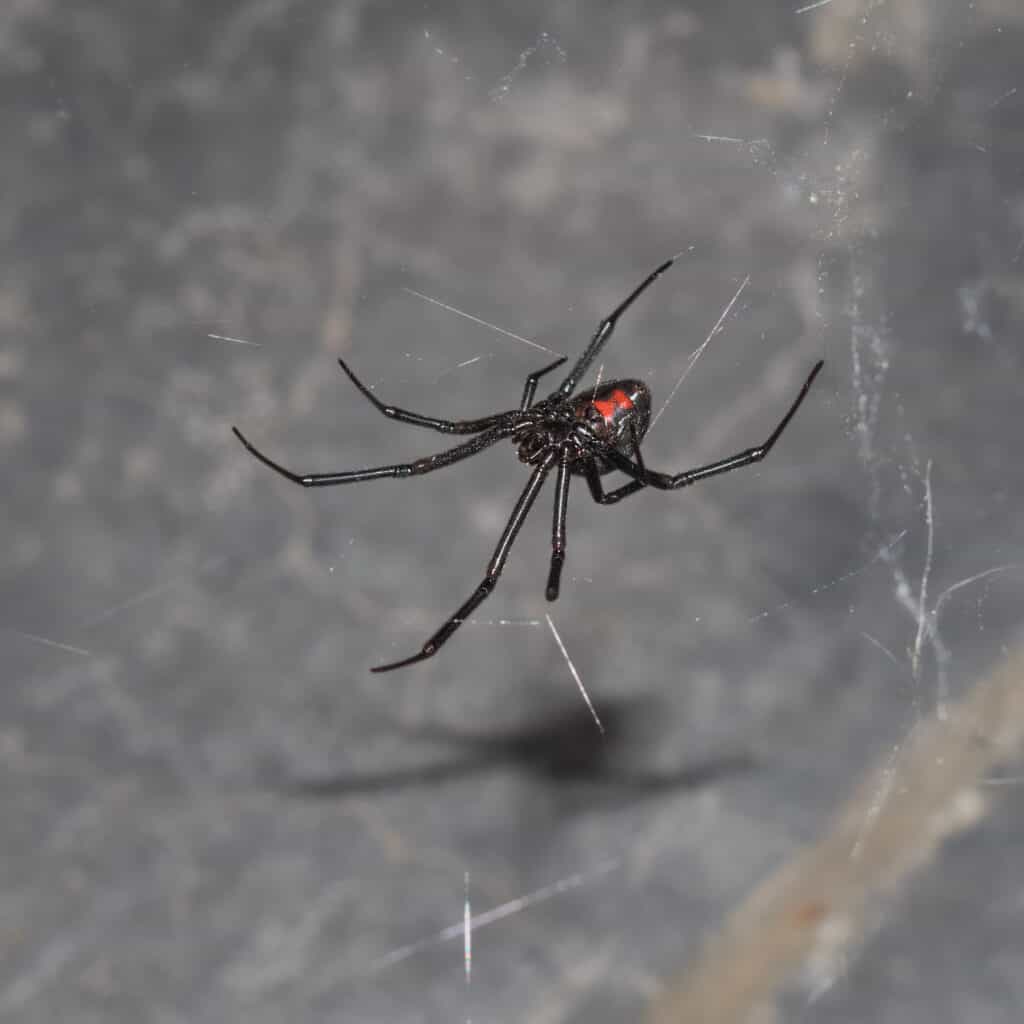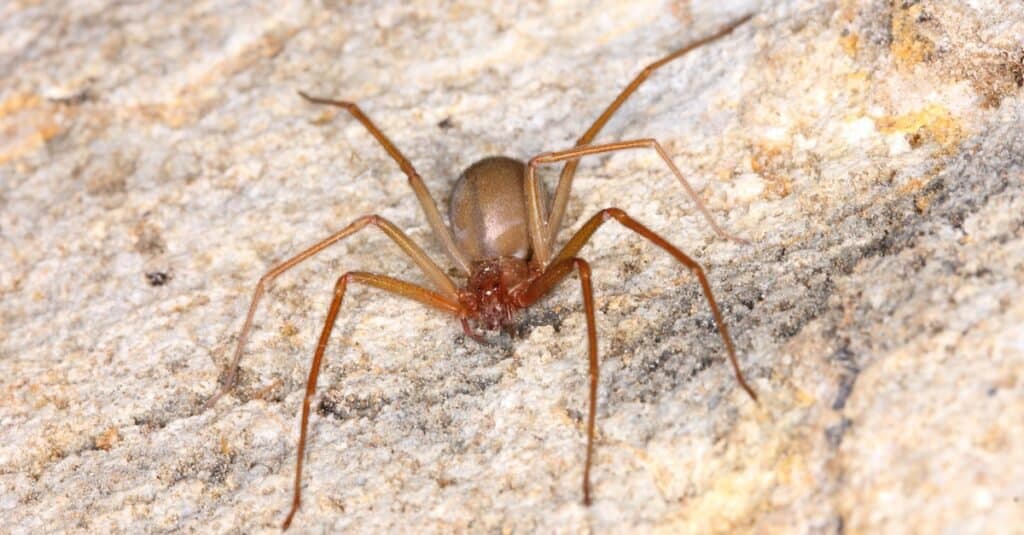Wyoming is a state where people that love the outdoors can thrive. This state is home to natural wonders like the geysers at Yellowstone and the Great Plains. Whether you live in the state or you’re just visiting this summer, though, you need to be aware that some creatures can cause you harm. While you’re more likely to look out for herds of bison than spiders, the latter can cause serious complications. That’s why we’re going to look at three of Wyoming’s most dangerous spiders.
You’ll learn what these spiders in Wyoming look like, what a bite can do, and where you are most likely to encounter them in your travels!

What Are Wyoming’s Most Dangerous Spiders?
Wyoming’s three most dangerous spiders are the western black widow, the brown recluse, and the yellow sac spider. Let’s start by saying that harmful bites from these spiders are rare, and fatalities are even rarer. Yet, it’s always good to be prepared.
Keep in mind that most if not all spiders have some sort of venom. The problem is not that these three spiders are venomous. The issue stems from the potency and impacts of Wyoming’s most dangerous spiders having venom that can cause necrotizing wounds or attack the nervous system.
While all this sounds scary, try not to be alarmed. The chances of you seeing one of these spiders without looking for them are low and your chances of being bitten by one are even lower.
Western Black Widow

A female Western Black Widow waits in her web for potential prey. These remarkable spiders have a highly toxic venom but are very passive, shy creatures.
©iStock.com/Shravan Sundaram Photography
The western black widow is the most dangerous spider in Wyoming. This species has a neurotoxic venom that can cause serious complications in humans.
The western black widow looks similar to other black widows in the United States. Adult female western black widows have shiny black bodies and legs with a red hourglass-shaped marking on the bottom of their abdomens. The red marking can be yellow or white as well. Sub-adult females may have other colorations on their abdomen.
Male western black widows are smaller, brown, and either lack powerful venom or mouthparts to deliver a harmful bite to human beings.
You are not likely to encounter a black widow. They prefer to live in dark places like wood piles or small holes in wooded areas, grasslands, or the outbuildings of homes. Black widows would rather not bite humans, but they will deliver a bite if they are trapped or squeezed by a human or trying to protect their eggs.
The black widow’s venom is neurotoxic to mammals. That means it attacks the nervous system of humans. Fortunately, their bites only deliver a relatively small amount to human bodies. In most cases, the bite from a black widow will cause minor irritation, a burning sensation, and swelling in the affected area.
Yet, some people experience more troubling symptoms such as:
- Sweating
- Stomach pain
- Nausea
- Vomiting
- Difficulty breathing
- Muscle weakness and tremors
These symptoms suggest a negative reaction to the spider’s bite and require immediate medical attention. That is especially true if the victim is a child or an elderly individual. Although it’s very rare, these bites can be fatal.
Brown Recluse

The brown recluse spider is one of the most dangerous spiders in the United States. Its venom destroys the walls of blood vessels near the site of the bite, sometimes causing a large skin ulcer.
©Pong Wira/Shutterstock.com
The brown recluse is another one of Wyoming’s most dangerous spiders, but its bite causes completely different effects than the black widow. The brown recluse is not native to this state. However, some reports of the spider appearing in the southeastern parts of the state mean that it could be spreading or that isolated families of them have accidentally made their way to the state. That’s why we are going to discuss this species.
The brown recluse spider has a common look to it. It’s a brown or tan spider that measures about half an inch in body length. They are known for their unusual dark brown marking on their back that resembles the shape of a violin or fiddle.
These spiders are rare in Wyoming, and you’re not likely to see one based on their preferred habitats. After all, they live in piles of debris and piles of wood. When they move into your home, they will usually infest dark storage spaces like attics, crawl spaces, and basements.
They may bite if they feel threatened. A bite from these spiders can sometimes but not always cause a necrotizing wound. That means their bites can destroy the tissue in and around the bite area. First, the wound will blister and turn a purplish color that indicates the bite is necrotic. Over the next 10 days or so, a scab will form and then fall off, leaving a depressed open ulcer.
If the individual does not receive proper care, the ulcer can become prone to secondary infections. Although it’s rare, these bites have caused cascading problems resulting in deaths. If you see any of these symptoms appearing, you should get checked by a doctor.
Yellow Sac Spider

Yellow Sac spider (Cheiracanthium) with prey in a pine tree. These dangerous spiders are prolific at night, and have similar venom to the Brown Recluse spider, only a milder dose.
©Brett Hondow/Shutterstock.com
The yellow sac spider often lives in tall vegetation. You can encounter them in the wild, but you are more likely to be bitten by one that is hunting for food. Sometimes, they will find their way into clothing like shoes or shirts. When a person puts one of those items on, the distressed spider bites them.
These spiders may be cream-colored with dark palps or present as a true yellow color with a cream-colored or yellow abdomen.
A bite from a yellow sac spider is similar to but less severe than a brown recluse bite. Their venom can make people feel mildly ill or create a blister that leaves a sore which takes weeks to heal. However, their wounds are much smaller than a brown recluse. It’s wise to see a doctor when you have what you suspect to be a serious spider bite. They’ll often start you on a course of antibiotics to prevent infections and can properly dress your wound.
Now that you know about where you’ll find Wyoming’s most dangerous spiders and what they can do, you should not be that afraid. These spiders can cause you harm, but it’s rather rare. You should respect these spiders and keep a safe distance from them, but the chances are low that you’ll ever see them.
Nevertheless, if you suspect that you have an infestation of these creatures in or around your home, it should be dealt with by professionals. Have a pest control company come to get rid of them with sprays and traps so you don’t have to fear for your safety.
Up Next:
- The Top 8 Most Dangerous Spiders Of North America
- Discover The Top Five Largest, Most Dangerous Spiders In Oklahoma This Summer!
- Discover The Top Five Largest, Most Dangerous Spiders In Montana This Summer!
- Discover The Top Five Largest, Most Dangerous Spiders In Nevada This Summer!
- Discover The Top Five Largest, Most Dangerous Spiders In Nebraska This Summer!
The photo featured at the top of this post is © iStock.com/Shravan Sundaram Photography
Sources
- Washington State University, Available here: https://entomology.wsu.edu/outreach/bug-info/yellow-sac-spider/#:~:text=Rarely%20are%20people%20bitten%20by,and%20rarely%20bite%20unless%20disturbed.
- Oxford Academic, Available here: https://academic.oup.com/mbe/article/30/5/999/992531
- Saint Louis Zoo, Available here: https://www.stlzoo.org/animals/abouttheanimals/invertebrates/spidersandscorpions/blackwidow
- University Of Wyoming, Available here: http://www.uwyo.edu/entomology/in-the-garden/spiders/yellow-sac-spider.html
- University of Wyoming, Available here: http://www.uwyo.edu/entomology/in-the-home/spiders/brown-recluse.html
Thank you for reading! Have some feedback for us? Contact the AZ Animals editorial team.






